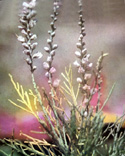| Latin Names | Tamarix gallica auct., Dyer in part, non Linn. (Tamaricaceae) |
| English Name | Tamarisk |
| Sanskrit Name | Jhavuka |
| Hindi Names | Jhav, Jhau |
 Distribution: It is found in North India in sandy or gravelly areas, low-lying saline soils and on the banks of rivers. Habit: T.g. is a gregarious, bushy shrub or a small tree. The bark is brownish, smooth when young and rough when mature; the leaves are minute, not sheathing; the flowers, pink or white, on long, very slender, spike-like racemes in terminal panicles; the capsules are conical, trigonous, tapering and pale pink; the seeds, with a plume of white hairs. Principle constituents: Tamarixin along with traces of its aglucone, tamarixetin. Indications: Because of its mild and sweet taste, it is used to move the bowels in children as well as in bleeding disorders like menorrhagia, bleeding per rectum and epistaxis. Product range: Bonnisan, Geriforte, Liv-52 |
|